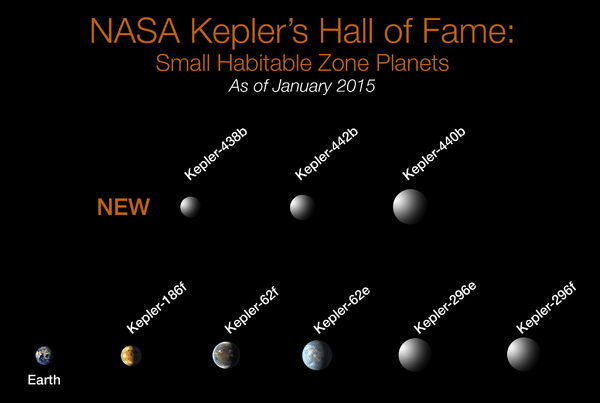Kepler-440b
| Exoplanet | List of exoplanets | |
|---|---|---|
| Parent star | ||
| Star | Kepler-440 | |
| Right ascension | (α) | 19h 01m 23.99s |
| Declination | (δ) | +41° 27′ 7.94″ |
| Apparent magnitude | (mV) | 15.134 |
| Distance | 851 ly (261 pc) | |
| Mass | (m) | 0.570 M☉ |
| Radius | (r) | 0.560 R☉ |
| Temperature | (T) | 4134 K |
| Metallicity | [Fe/H] | −0.300 |
| Physical characteristics | ||
| Radius | (r) | 1.860 R⊕ |
| Temperature | (T) | 273 K (0 °C; 32 °F).[2] |
| Orbital elements | ||
| Semi-major axis | (a) | 0.24200 AU |
| Eccentricity | (e) | >0.340 |
| Orbital period | (P) | 101.11141000 d |
| Inclination | (i) | 89.930° |
| Discovery information | ||
| Discovery date | 2015[3] | |
| Discoverer(s) | ||
| Discovery method | Transit | |
| Discovery site | Kepler Space Observatory | |
| Discovery status | Published refereed article | |
| Other designations | ||
| KOI-4087.01; Kepler-440 b; KOI-4087 b; K04087.01; WISE J190124.00+412708.3 b; KIC 6106282 b; 2MASS J19012398+4127079 b | ||
| Database references | ||
| Extrasolar Planets Encyclopaedia | data | |
| SIMBAD | data | |
| Exoplanet Archive | data | |
| Open Exoplanet Catalogue | data | |
Kepler-440b (also known by its Kepler Object of Interest designation KOI-4087.01) is a confirmed super-Earth exoplanet orbiting within the habitable zone of Kepler-440, about 850 light-years (261 pc) from Earth.[1] The planet was discovered by NASA's Kepler spacecraft using the transit method, in which the dimming effect that a planet causes as it crosses in front of its star is measured. NASA announced the confirmation of the exoplanet on 6 January 2015.[4]
Confirmed exoplanet
Kepler-440b is a super-Earth with a radius 1.86 times that of Earth. The planet orbits Kepler-440 once every 101.1 days.[1]
Habitability
The planet was announced as being located within the habitable zone of Kepler-440, a region where liquid water could exist on the surface of the planet.[1]
| Notable Exoplanets – Kepler Space Telescope |
|---|

(Kepler-62e, Kepler-62f, Kepler-186f, Kepler-296e, Kepler-296f, Kepler-438b, Kepler-440b, Kepler-442b) (Kepler Space Telescope; 6 January 2015).[4] |
See also
References
- 1 2 3 4 Torres, Guillermo; Kipping, David M.; Fressin, Francois; Caldwell, Douglas A.; Twicken, Joseph D.; Ballard, Sarah; Batalha, Natalie M.; Bryson, Stephen T.; Ciardi, David R.; Henze, Christopher E.; Howell, Steve B.; Isaacson, Howard T.; Jenkins, Jon M.; Muirhead, Philip S.; Newton, Elisabeth R.; Petigura, Erik A.; Barclay, Thomas; Borucki, William J.; Crepp, Justin R.; Everett, Mark E.; Horch, Elliott P.; Howard, Andrew W.; Kolbl, Rea; Marcy, Geoffrey W.; McCauliff, Sean; Quintana, Elisa V. (2015). "Validation of Twelve Small Kepler Transiting Planets in the Habitable Zone". arXiv:1501.01101
 [astro-ph.EP].
[astro-ph.EP]. - ↑ "HEC: Data of Potential Habitable Worlds".
- ↑ Staff (2015). "Planet Kepler-440 b". The Extrasolar Planets Encyclopaedia. Retrieved 11 January 2015.
- 1 2 Clavin, Whitney; Chou, Felicia; Johnson, Michele (6 January 2015). "NASA's Kepler Marks 1,000th Exoplanet Discovery, Uncovers More Small Worlds in Habitable Zones". NASA. Retrieved 6 January 2015.
External links
| Wikimedia Commons has media related to Kepler Mission. |
- NASA – Kepler Mission.
- NASA – Kepler Discoveries – Summary Table.
- NASA – Kepler-440b at The NASA Exoplanet Archive.
- NASA – Kepler-440b at The Extrasolar Planets Encyclopaedia.
- Habitable Exolanets Catalog at UPR-Arecibo.
Coordinates: ![]() 19h 01m 23.99s, +41° 27′ 07.94″
19h 01m 23.99s, +41° 27′ 07.94″


